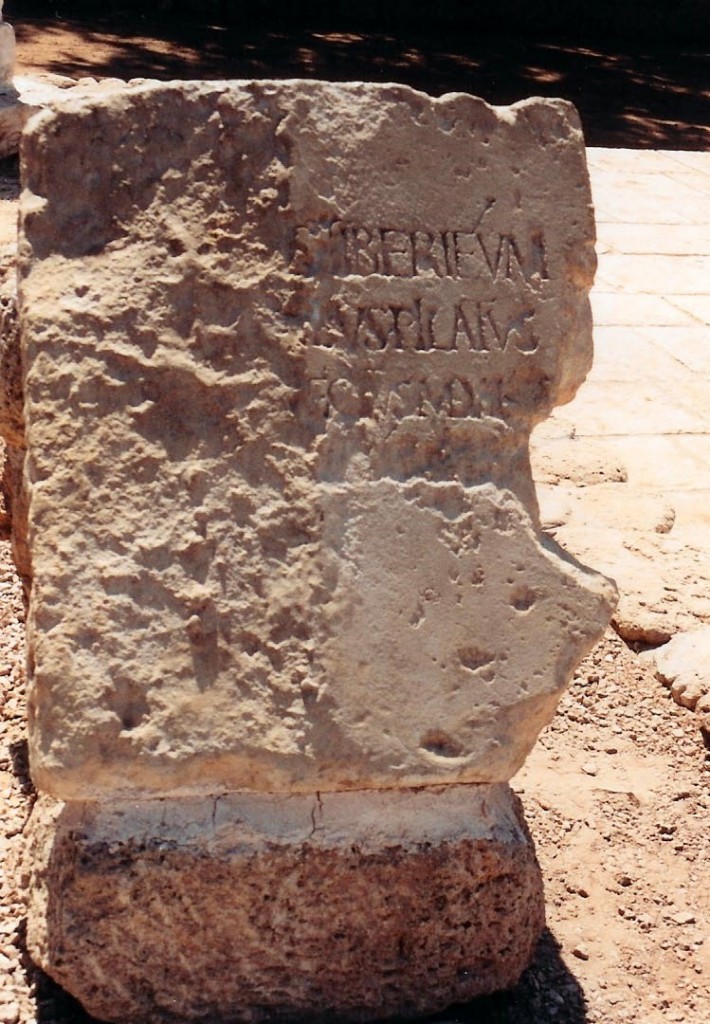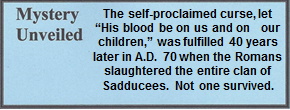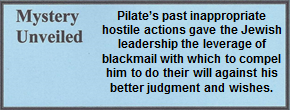16.01.06 Mt. 27:24-25
PILATE WASHES HIS HANDS
24 When Pilate saw that he was getting nowhere, but that a riot was starting instead, he took some water, washed his hands in front of the crowd, and said, “I am innocent of this man’s blood. See to it yourselves!”
25 All the people answered, “His blood be on us and on our children!” 26 Then he released Barabbas to them. But after having Jesus flogged, he handed Him over to be crucified.
The accusers presented alleged offenses, but could not convince Pilate that Jesus was guilty of any crime. The progression of Pilate’s attempts to release Jesus is noteworthy.
- First he attempted to ignore the case
- Then he tried to release Jesus in light of the Passover tradition of releasing a condemned prisoner.
- Then he had Jesus scourged believing this would satisfy the Jewish crowd.
- After three successive failures, he attempted his last appeal.
Finally, Pilate surrendered to Caiaphas and his hysterical mob. Since there was no defense, Pilate pronounced execution by crucifixion.[1] He then “took some water, [and] washed his hands.” This was the sixth and final declaration of innocence concerning the charges against Jesus of Nazareth. The washing of hands was a common ritualistic act that declared innocence when a life was lost by accident. The washing of hands was already at this time an ancient symbol among many cultures for declaring innocence involving the death of a person. Some fourteen centuries earlier, Moses recorded the atonement for an unsolved murder that included the elders of the town washing their hands over the broken neck of a heifer (Deut. 21:6-9). David did likewise in Psalm 26:6 and 73:13. As Pilate would eventually learn, his guilt could not be washed away because he was guilty.
He then announced, “I am innocent of this man’s blood.” However, that statement did not release him from the consequences and responsibility for his decision. He failed to stand up for what was right, but instead, caved in to the pressure of a minority group. Even his wife had warned him. He could have given Jesus His freedom, exiled Him from the country, or invoked any number of other options, but he didn’t. It is ironic that pagan justice was more just than the justice of the Jews, who were to represent the love and justice of God.
Furthermore, Josephus stated that Pilate attempted to abolish Jewish laws, set up statues at night without the knowledge of the local religious leaders, and used temple money to bring water into Jerusalem. Pilate eliminated his opponents by having his soldiers wear street clothes, surround the opponent in a crowded street, and at a given signal, they stabbed him. The soldiers would then keep on walking and disperse.[2] It was a tactic used by the Zealots, whom the Romans called Sicarii. Clearly, Pilate disliked the Jews and their religion. Overall, he failed to offer them consideration afforded by other Roman prefects. He frequently reflected the beliefs and lifestyle of Antiochus IV Epiphanes, who ruled some two centuries earlier.
Pilate may have claimed innocence by the washing of his hands, but God did not see it that way. The rest of his life was in constant turmoil. He met his demise as the result of his response to a Samaritan “rebellion.” Some scholars believe it was a messianic movement while others say that a certain imposter claimed to have found some artifacts that were hidden by Moses. Regardless, in A.D. 36 Pilate sent his troops to the Samaritan village of Tirabatha and the result was a huge slaughter of innocent people.[3] The Samaritans complained to Vitellius, telling him that the whole matter was not a rebellion, but a harmless religious movement. Furthermore, Pilate’s soldiers killed many refugees.
When the senseless killing became known in Roman circles, Pilate was ordered by Vitellius, the legate of Syria, to sail to Rome and defend himself. However, by the time he arrived, Emperor Tiberius had died. Nonetheless, he was removed from office.[4] According to Eusebius, Pilate was exiled and committed suicide, although another account says he suffered death under Emperor Nero.[5] The account of Pilate’s last days as recorded by the early church father Eusebius is as follows:
It is proper also to observe how it is asserted that this same Pilate, who was governor at our Savior’s crucifixion, in the reign of Gaius (Caligula), whose times we are recording, fell into such calamities that he was forced to become his own murderer, and the avenger of his own wickedness. Divine justice, it seems, did not long protract his punishment. This is stated by those Greek historians who have recorded the Olympiads in order together with the transactions of the times.
Eusebius, Church History 2.7.1[6]

16.01.06.A. INSCRIPTION OF PILATE AND TIBERIUS. A monument with an inscribed reference to Pilate and Tiberius was discovered in 1961 for a building known as the Tiberius. It was the dedication stone of the Roman theater in Caesarea Maritima built by the architectural genius, Herod the Great. Photographed by the author at Caesarea. The inscription completed (below) by the Israel Museum.
This damaged inscription is the only one found that refers to Pilate. Notice that his title was “Praefectus Iduaeae” or Prefectus Judaea. Until this time, scholars believed the official title of Pilate to have been “procurator.”[7]
[Dis Augusti]s Tiberieum
[-Pon]tius Pilatus
[praef]ectus Idua[ea]e
[fect, d]e[dicavit]
16.01.06.B. THE INSCRIBED LATIN WORDS THAT HONOR PILATE AND TIBERIUS.
“His blood be on us and on our children.” In the rage and anger of mob hysteria, the Jews (namely the Sadducees and their friends) eagerly cursed themselves and their future generations. The power of words by mere mortals is, at times, more dynamic and powerful than can possibly be imagined. Forty years later the entire Sadducean leaders and their families were slaughtered by the Romans as the temple was destroyed. Furthermore, two thousand years of history demonstrate that this curse has followed them throughout the world.

The fact remains that Jesus still had an immense following of people who desired to see Him become the political-messiah who would bring national independence and greatness as King David had done. The gospels place the blame for the death of Jesus upon the national leadership of the Jewish nation, as well as the Romans. Reasons for His death are historical, theological, and spiritual, but not racial.
Conclusion
Pilate had a devotion for doing whatever pleased himself, with little or no regard to anyone else, and especially the Jews. This is clearly evident in a letter written by Philo around the year A.D. 41. Philo, discussing the attempted placement of a statue of Gaius Caligula in the temple, inserted a description of Pilate. Philo said that,
[Pilate used] briberies, insults, robberies, outrages, wanton injuries, constantly repeated executions without trial, ceaseless and supremely grievous cruelty.
Philo, On the Embassy to Gaius 302
Philo continued his description of Pilate as one who willingly accepted bribes, committed unjust acts of violence, and shamefully treated many. In fact, the Jews looked upon the days of Herod the Great with regret as life had become much more difficult under Pilate.[8] However, the long arm of justice eventually caught up with him. Shortly after the crucifixion of Jesus, Rome became uneasy with the job performances of both Caiaphas and Pilate. The corruption and cruelty of these two men became more than the Emperor Gaius and Roman Senate could tolerate. So sometime around late A.D. 36, according to Josephus,
[The Syrian governor, Vitellius] ordered Pilate to return to Rome to give the emperor his account of the matters with which he was charged…[9]
[and] he removed from his sacred office the high priest Joseph, surnamed Caiaphas, and appointed in his stead Jonathan, son of Ananus the high priest.[10]
Josephus, Antiquities 18.4.2, 3 (89, 95b)
By the summer of A.D. 37, both men were removed from office. Nonetheless, the fact is that Pilate was one of the most corrupt and cruel procurators Israel ever had. Yet it is incredible that a monarch of such depraved character had to admit that he could find no fault in Jesus.[11] Both gospel writers noted the triadic insistence for two reasons:
- Pilate really did come before the crowd and declare Jesus was innocent and,
- The triadic structure which Pilate gave, communicated to the Jewish people that this was
the most emphatic insistence that he could give to declare innocence of Jesus.
In summary, up until this time there were three major errors committed by Pilate which profoundly influenced his decision concerning Jesus.
- In A.D. 26, shortly after he arrived in Caesarea, he entered Jerusalem with Roman military standards with the busts of the emperor on them. This violated the Jewish commandment of not having graven images. Every previous prefect had the images removed before marching troops into Jerusalem, but Pilate lacked that sensitivity. For five days and five nights the Jews protested. When Pilate realized the Jews were willing to die for their law, he withdrew his standards in humiliation.[12]
- He took funds from the temple to finance the completion of a new aqueduct that was begun by Herod the Great. This caused a huge protest among the Jews which Josephus estimated to have been in the tens of thousands. Many were severely injured, dozens killed either by the sword or being trampled upon by horses. The protest ended with a bloody legacy. There can be little doubt that word of this event reached Rome.[13]
- He placed votive shields with the emperor’s name richly engraved and gilded, in Herod’s palace in Jerusalem to the honor and memory of the monarch.[14] It is believed that Herod Antipas and his brother Philip[15] successfully presented complaints before the emperor against Pilate for having set up these offensive shields.[16] Hence, they were removed and hung in the temple of Augustus in Caesarea.[17]
The power of Pilate over the people was broken. Pilate had lost all three confrontations and some historians believe that Caesar was aware of them. From that time on the Jews knew how to extort concessions from him. Philo, a Jewish philosopher who lived in Egypt, said that the Jews threatened to report the misdeeds of Pilate to the Emperor.[18] Obviously, later the leading Jews essentially blackmailed him into crucifying Jesus, as he feared they would go to Rome and file a complaint with the emperor. His career was clearly on the line. Ironically, his final misjudgment was a massacre of many Samaritans a few years later that ended his stay in the Middle East.

In addition, there are two other points to consider.
- In the year 35 or 36, a few years after the ministry of Jesus ended, there was a false prophet in Samaria. The prophet said that he claimed to know where Moses had hidden certain artifacts on Mount Gerizim and crowds of people came to see them. At this point, Pilate commanded his soldiers to kill and crucify many in the crowd.[19] This was his final act of violence against innocent people. Vitellius, the legate of Syria ordered him to report to Rome and explain his actions, after which he was banished in exile.
- Pilate had a general attitude of disrespect toward the Jewish people, so much so, eventually it was part of the consideration to have him removed from office. Concerning him, Philo said the following charges were made against him:
Corruptibility, violence, robberies, ill-treatment of the people, grievances, continuous executions without even the form of a trial, endless and intolerable cruelties.
Philo, De Legatione ad Cajum 38:299-305
And so ended the career of Pilate. Tradition says it was in exile that he committed suicide.
16.01.06.Q1 What happened to those who opposed Jesus (see also 03.05.18.Q1)?
All those who opposed Jesus met horrific deaths, just as did those three men who previously desecrated the holy temple.[20] Divine judgment followed those who were involved in both the planning of the crucifixion and the final act. Note the following brief accounts:
- Herod the Great rebuilt the temple but lived a violent and decadent lifestyle, abused the Jewish people and introduced as much Hellenism as he could into the culture. His body began to decay while he was still living. Furthermore, by the end of the first century, the entire Herodian dynasty was gone.
- The entire family of Annas, the father-in-law of Caiaphas, was destroyed during the First Revolt as the Romans attacked the Holy City. A vicious mob dragged one young man through the streets of Jerusalem until the skin on his back was shredded off, and he was beaten to an agonizing death.
- The entire Sadducean religious party was destroyed with the temple.
- As stated above, Pilate met his demise as the result of his horrific response to a Samaritan “rebellion,” that was merely a religious movement. Consequently, in A.D. 36 he was exiled and then committed suicide.[21]
- Herod Antipas was deposed and died in exile.
- The Sanhedrin no longer met in the temple’s Chamber of Hewn Stone, but was relocated to the Hill of Evil Counsel nearby.[22] It was disbanded around the year 360.[23]
God’s judgment was also on those who violated His holy temple. See 03.05.18.Q1 “What happened to those who violated the second temple?”
On an interesting side note, due to Roman persecutions against Christians, many early church leaders blamed all the Jews rather than the Sadducees and Romans for the crucifixion of Jesus. A few went as far as to speak highly of Pilate, even though church liturgy clearly stated that it was Pilate who sent Jesus to the cross. In fact, Tertullian who was one of the early church fathers around A.D. 200, referred to Pilate as being “Christian in his conscience.” The Greek Orthodox Church canonized Pilate’s wife Procula, and the Ethiopian Church recognizes June 25 as “St. Pilate and St. Procula’s Day.”[24]
[1]. Sherwin-White, Roman Society and Roman Law in the New Testament. 25.
[2]. Josephus, Antiquities. 18.3.1-2.
[3]. Webb, “The Roman Examination and Crucifixion of Jesus.” 721-22.
[4]. Josephus, Antiquities 18.4.1-2; also 09.03.08 and 15.04.05.
[5]. Josephus, Antiquities 18.4.1-2; Farrar, Life of Christ. 432-36.
[6]. Elwell and Yarbrough, Readings from the First-Century World. 44; Farrar, Life of Christ. 433.
[7]. Zondervan’s New International Version Archaeological Study Bible. (2005 ed.). 1714.
[8]. Philo, On the Embassy to Gaius 1033.
[9]. Judea and all the Jewish lands controlled by Pilate, Herod Philip, and Herod Antipas, were part of the larger district of Syria, of which the capital was Damascus. Therefore, Pilate reported to Vitellius, governor of Syria, who reported to Emperor Gaius.
[10]. Ananus held the title of high priest even though he was retired and no longer functioned in that office. It was a title of honor that was held throughout life.
[11]. Lk. 23:4; 13-16; 22; Jn. 18:38b; 19:4; 19:6.
[12]. Josephus, Antiquities 18.3.1 (55-57); Wars 2.9.2-4 (169-177); Philo, Embassy to Gaius 301-02.
[13]. Josephus, Antiquities 18.3.1 (55-57); Wars 2.9.2-4 (169-177); Philo, Embassy to Gaius 301-02.
[14]. Philo, On the Embassy to Gaius 24:159-61; Pentecost, The Words and Works of Jesus Christ. 469.
[15]. Their brother Archelaus was no longer in the land after A.D. 6. Some scholars question if it was these two brothers (Antipas and Philip) who argued before the emperor, since Herod the Great had three other sons who did not inherit lands to govern: Herod the son of Mariamne, Herod the son of Cleopatra, and Phasael the son of Pallas. It is possible two of these brothers went to Rome and argued against Pilate. See Josephus, Antiquities 17.1.3; Wars 1.28.4; Philo On the Embassy to Gaius 30.
[16]. Schurer, A History of the Jewish People First Division, 2:40-42; Geikie, The Life and Words of Christ. 1:284.
[17]. Geikie, The Life and Words of Christ. 1:296.
[18]. Quoted by Barclay, “Matthew.” 2:358-59.
[19]. Josephus, Antiquities 18.4.1.
[20] See also 03.05.18.Q1 “What happened to those who violated the second Jewish temple?”
[21]. Eusebius, Ecclesiastical History 2.7.
[22]. How interesting it is that today the United Nations is located on this hill.
[23]. Parry, The Complete Idiot’s Guide to the Talmud. 37.
[24]. Yamauchi, “Concord, Conflict and Community.” 170.